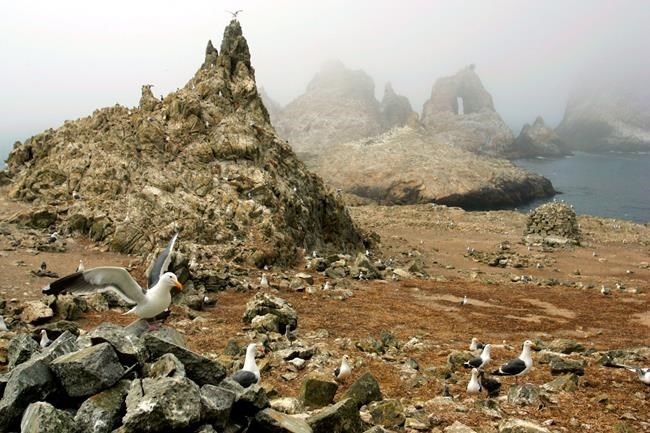
FILE - In this July 8, 2006, file photo, gulls nest near the North Landing area of the Farallon Islands National Refuge, Calif. The California Coastal Commission on Wednesday, July 10, 2019, will hear public comment on a federal plan to drop 1.5 tons of rat poison on the Farallon Islands in an effort to eradicate a mice infestation, a proposal that is drawing criticism. (AP Photo/Ben Margot, File)
Republished July 10, 2019 - 4:06 PM
Original Publication Date July 10, 2019 - 2:21 PM
SAN FRANCISCO - Federal wildlife officials were urged Wednesday to withdraw a proposal to drop 1.5 tons of rat poison on remote islands off the coast of California to kill a mice infestation until they address questions on the impact to wildlife.
The California Coastal Commission heard public comment on the U.S. Fish and Wildlife Service plan, which has drawn criticism from local conservation groups. The commission is seeking to determine whether the plan complies with state coastal management rules.
The U.S. Fish and Wildlife Service said in a report presented to the commission in March that a massive house mice population is threatening the whole ecosystem on the rugged Farallon Islands, 27 miles (44 kilometres) off the coast of San Francisco.
The archipelago is home to the largest seabird breeding colony in the contiguous United States, with approximately 300,000 to 350,000 birds of 13 species, including the rare ashy storm petrels. The islands are also used by marine mammal species for resting and breeding and by migratory birds.
Federal wildlife officials proposed using helicopters to dump 2,900 pounds (1,315 kilograms) of cereal grain pellets laced with brodifacoum, an anticoagulant that causes rodents to bleed to death. The substance is banned in California.
Officials acknowledged the plan will kill some seagulls and other species but argue that the benefits of eliminating the invasive species will heal the whole ecosystem.
"The only way to protect these species and allow the ecosystem to recover is 100% eradication of the mice," said Pete Warzibok, a biologist who has worked on the Farallon Islands for more than 20 years. "Anything else is simply a stopgap measure that will not adequately address the problem."
Critics argued the poison will not only kill the mice, first introduced by ships that stopped in the islands 200 years ago, but also wildlife on the island and scavengers that would feed on the carcasses of the poisoned animals.
"These poisons are deadly, they persist in the environment for hundreds of days and they do kill animals," said Alison Hermance, the spokeswoman for the conservation group WildCare.
"The situation on the Farallon Islands has existed for decades. It does not need to be solved overnight with a massive poison drop," she said.
The commission has no power to veto the plan but before federal officials can proceed, their plan needs approval from the various state and federal agencies.
After a nearly two-hour hearing Wednesday, commissioners said they still have questions on the effect on seabirds and other species. "We haven't been convinced that this is the best and only way to go," Commission Chairwoman Dayna Bochco said.
The commissioners asked federal officials to withdraw the proposal and resubmit it after their questions have been answered.
The project would be implemented in the November-December time period when the mouse population is declining and food stressed, and would occur no sooner than late 2020.
News from © The Associated Press, 2019